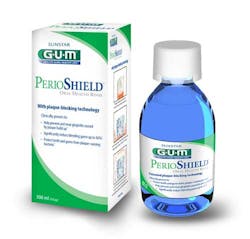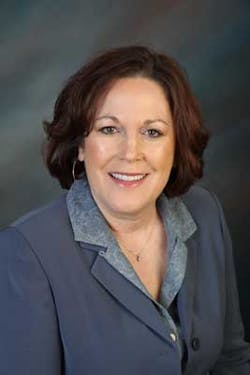Delmopinol hydrochloride rinse interferes with plaque, bacteria adherence
By Noel Brandon-Kelsch, RDH
Every day dental health care professionals are faced with the task of assessing products pro’s and con’s and determining if they meet the needs of patients and are safe to use. One of the areas that clients ask about repeatedly, “Is there anything out there that can stop plaque from forming?” There finally is!
Every day dental health care professionals are faced with the task of assessing products pro’s and con’s and determining if they meet the needs of patients and are safe to use. One of the areas that clients ask about repeatedly, “Is there anything out there that can stop plaque from forming?” There finally is!
PerioShield consists of a key ingredient, delmopinol hydrochloride 0.2%. This is the ingredient that allows the Food and Drug Administration to classify PerioShield as a class II medical device rather than a drug.(1) No other mouth rinse has this distinction. The reason it is a medical device is it possesses actions that can interfere with plaque/biofilm and bacteria adherence (see So how does it work? section below). This makes a huge difference in clients who experience chronic gingivitis and heavy plaque.(2) More than a thousand patients in five countries were tested with this product ranging in age from 18-73. They all had the same results. Gingival bleeding reduction up to 36% in 6-month duration(3) as well as plaque reduction of 35% in a 6-month duration.(3) Compared with Chlorhexidine, Delmopinol stains much less.(2) The delmopinol 0.2% rinse was shown to effectively interfere with the mechanism of plaque/biofilm adherence and manage gingivitis.So how does it work?
This product does not kill bacteria it works on other angles of prevention. It creates an environment that will not allow plaque biofilm and bacteria to adhere. Sinclair Pharma, the developer of the delmopinol hydrochloride, explains how it works at many stages of the process:(4)1. Disrupts the existing plaque matrix by reducing the viscosity of glucans and loosening the cohesive properties of plaque, making it easier to remove mechanically.(5,6,7)2. Slows the formation of salivary pellicle on clean surfaces, the priming step required for bacterial attachment to the teeth and gingiva.(8,9) 3. Reduces the adherence of pioneer bacteria to salivary pellicle on tooth and gingival surfaces.(10,11)4. Reduces adherence of colonizing bacteria to the plaque matrix.(12)5. Bacteria do not adapt to delmopinol hydrochloride, whereas they do adapt to chlorhexidine.(13)6. In a range of studies delmopinol hydrochloride has proven effective in reducing plaque and gingivitis.(14,15)So how is it used?
This product is available over the counter (OTC). It is recommended to rinse twice a day (morning and evening) for 30 seconds. The product has a low 1.5% alcohol content and is safe and effective for long-term use. The other side effect that was noted was a short duration tingling of the tongue. There is finally an answer to a client’s inquiry for something to prevent gingivitis and periodontal disease. This FDA approved mechanical device has been shown to effectively interfere with the mechanism of plaque biofilm adherence and manage gingivitis. PerioShield is a great addition to the armamentarium of prevention. References
1. MSDS Sheet PerioShield2. Addy, Moran, et al. Meta-analyses of studies of 0.2% delmopinol mouth rinse as an adjunct to gingival health and plaque control measures. J Clin. Periodontol 2007;34:58-65.3. Lang, Hase, et al. Plaque formation and gingivitis after supervised mouthrinsing with 0.2% delmopinol hydrochloride, 0.12% chlorhexidine digluconate and placebo for 6 months. Oral Diseases 1998;4:105-113.4. www.sinclairispharma.com/information-for-dentists.html5. Klinge B, Matsson L, Attström R, Edwardsson S, Sjödin T. Effect of local application of delmopinol hydrochloride on developing and early established supragingival plaque in humans. J Clin Periodontol 1996;23:543-547.6. Rundegren J, Arnebrant T. Effect of delmopinol on the viscosity of extracellular glucans produced by Streptococcus mutans. Caries Res 1992;26:281-285.7. Rundegren J, Simonsson T, Petersson L, Hansson E. Effect of delmopinol on the cohesion of glucan-containing plaque formed by Streptococcus mutans in a flow cell system. J Dent Res 1992;71:1792-1796.8. Vassilakos N, Arnebrant T, Rundegren J. In vitro interactions of delmopinol hydrochloride with salivary films adsorbed at solid/liquid interfaces. Caries Research 1993; 27: 176-182.9. Steinberg D, Beeman D, Bowen W. The effect of delmopinol on glucosyltransferase adsorbed on to saliva-coated hydroxyapatite. Archs Oral Biol 1992;37:33-38.10. Simonsson T. In vitro studies on bacterial adhesion and bacterial colony formation on solid surfaces precoated with M1650 in a flow cell system. In house data.11. Simonsson T. Influence of delmopinol, dissolved in four different buffers, on bacterial adhesion and subsequent colony formation in a flow cell system. In house data.12. Rundegren J Delmopinol hydrochloride reduces saliva-mediated coaggregation between Actinobacillus actinomycetemcomitans and Actinomyces spp. In house data.13. Hase JC, Edwardsson S, Rundegren J, Attstrom R, Kelty E. 6-month use of 0.2% delmopinol hydrochloride in comparison with 0.2% chlorhexidine digluconate and placebo. J Clin Periodontol 1998;25:841-849.14. Lang NP, Hase JC, Grassi M, et al. Plaque formation and gingivitis after supervised mouthrinsing with 0.2% delmopinol hydrochloride, 0.2% chlorhexidine digluconate and placebo for 6 months. Oral Diseases 1998;4:105-113.15. Addy M, Moran J, Newcombe RG. Meta-analyses of studies of 0.2% delmopinol mouth mouthwash as an adjunct to gingival health and plaque control measures. J Clin Periodontol.
This product does not kill bacteria it works on other angles of prevention. It creates an environment that will not allow plaque biofilm and bacteria to adhere. Sinclair Pharma, the developer of the delmopinol hydrochloride, explains how it works at many stages of the process:(4)1. Disrupts the existing plaque matrix by reducing the viscosity of glucans and loosening the cohesive properties of plaque, making it easier to remove mechanically.(5,6,7)2. Slows the formation of salivary pellicle on clean surfaces, the priming step required for bacterial attachment to the teeth and gingiva.(8,9) 3. Reduces the adherence of pioneer bacteria to salivary pellicle on tooth and gingival surfaces.(10,11)4. Reduces adherence of colonizing bacteria to the plaque matrix.(12)5. Bacteria do not adapt to delmopinol hydrochloride, whereas they do adapt to chlorhexidine.(13)6. In a range of studies delmopinol hydrochloride has proven effective in reducing plaque and gingivitis.(14,15)So how is it used?
This product is available over the counter (OTC). It is recommended to rinse twice a day (morning and evening) for 30 seconds. The product has a low 1.5% alcohol content and is safe and effective for long-term use. The other side effect that was noted was a short duration tingling of the tongue. There is finally an answer to a client’s inquiry for something to prevent gingivitis and periodontal disease. This FDA approved mechanical device has been shown to effectively interfere with the mechanism of plaque biofilm adherence and manage gingivitis. PerioShield is a great addition to the armamentarium of prevention. References
1. MSDS Sheet PerioShield2. Addy, Moran, et al. Meta-analyses of studies of 0.2% delmopinol mouth rinse as an adjunct to gingival health and plaque control measures. J Clin. Periodontol 2007;34:58-65.3. Lang, Hase, et al. Plaque formation and gingivitis after supervised mouthrinsing with 0.2% delmopinol hydrochloride, 0.12% chlorhexidine digluconate and placebo for 6 months. Oral Diseases 1998;4:105-113.4. www.sinclairispharma.com/information-for-dentists.html5. Klinge B, Matsson L, Attström R, Edwardsson S, Sjödin T. Effect of local application of delmopinol hydrochloride on developing and early established supragingival plaque in humans. J Clin Periodontol 1996;23:543-547.6. Rundegren J, Arnebrant T. Effect of delmopinol on the viscosity of extracellular glucans produced by Streptococcus mutans. Caries Res 1992;26:281-285.7. Rundegren J, Simonsson T, Petersson L, Hansson E. Effect of delmopinol on the cohesion of glucan-containing plaque formed by Streptococcus mutans in a flow cell system. J Dent Res 1992;71:1792-1796.8. Vassilakos N, Arnebrant T, Rundegren J. In vitro interactions of delmopinol hydrochloride with salivary films adsorbed at solid/liquid interfaces. Caries Research 1993; 27: 176-182.9. Steinberg D, Beeman D, Bowen W. The effect of delmopinol on glucosyltransferase adsorbed on to saliva-coated hydroxyapatite. Archs Oral Biol 1992;37:33-38.10. Simonsson T. In vitro studies on bacterial adhesion and bacterial colony formation on solid surfaces precoated with M1650 in a flow cell system. In house data.11. Simonsson T. Influence of delmopinol, dissolved in four different buffers, on bacterial adhesion and subsequent colony formation in a flow cell system. In house data.12. Rundegren J Delmopinol hydrochloride reduces saliva-mediated coaggregation between Actinobacillus actinomycetemcomitans and Actinomyces spp. In house data.13. Hase JC, Edwardsson S, Rundegren J, Attstrom R, Kelty E. 6-month use of 0.2% delmopinol hydrochloride in comparison with 0.2% chlorhexidine digluconate and placebo. J Clin Periodontol 1998;25:841-849.14. Lang NP, Hase JC, Grassi M, et al. Plaque formation and gingivitis after supervised mouthrinsing with 0.2% delmopinol hydrochloride, 0.2% chlorhexidine digluconate and placebo for 6 months. Oral Diseases 1998;4:105-113.15. Addy M, Moran J, Newcombe RG. Meta-analyses of studies of 0.2% delmopinol mouth mouthwash as an adjunct to gingival health and plaque control measures. J Clin Periodontol.
Noel Brandon-Kelsch is a speaker, writer and Registered Dental Hygienist in Alternative Practice. She is the Infection Control Columnist for RDH® magazine, a syndicated newspaper columnist, has been published in many books and has brought the message of oral health to networks from Disney Radio to ESPN. Noel consults to Sunstar as a speaker and Key Opinion Leader.


